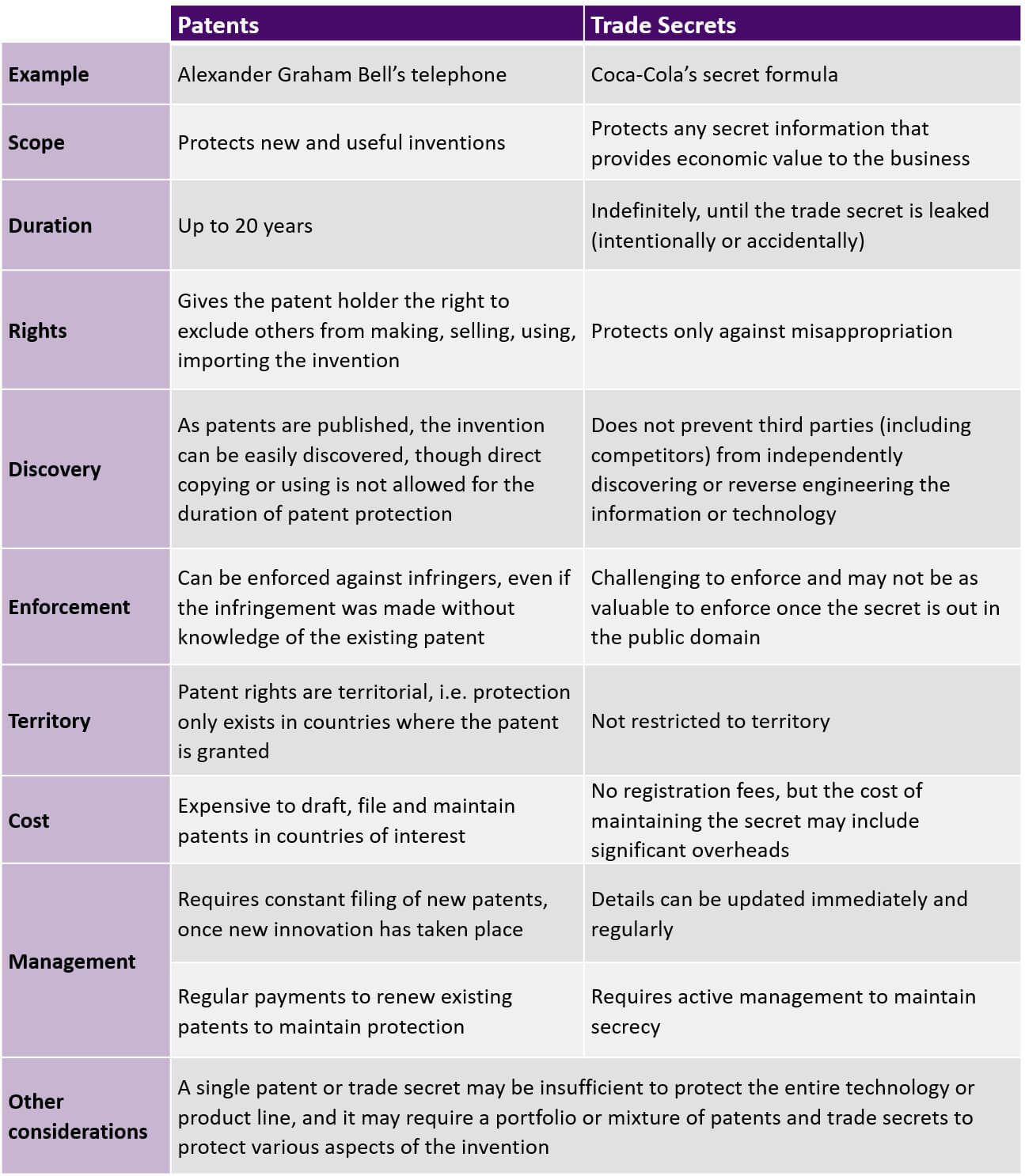
Patents and Trade Secrets: A Dual Strategy for Business Growth

Patents or trade secrets? Many companies grapple with choosing between the two when it comes to protecting their innovations, especially in the face of shrinking budgets. Patents require disclosure of the invention and tend to be expensive while trade secrets hinge on secrecy and is “almost free”. These options need not be mutually exclusive. An understanding of how the innovation aligns with business strategy will allow the company to craft an intellectual property (IP) protection strategy that works for the long term. In fact, employing a complementary approach can potentially reap greater value for the business.
A successful balancing act
Wyeth, a pharmaceutical company, used both patents and trade secrets to protect Premarin, a drug for treating menopause-related symptoms. Wyeth had patented its drug formulation in the 1940s1 but kept its manufacturing processes a trade secret. With this approach, Wyeth not only kept Premarin exclusive during its patent term, but has also successfully extended its monopoly by protecting its trade secret from generic manufacturers.
More recently, Moderna announced that it would “not enforce” its COVID-19 related patents against other companies making vaccines to combat COVID-192. While this stance has been commended by many, one cannot overlook the fact that Moderna employs an IP strategy that uses both patents and trade secrets. On the one hand, Moderna’s patents send a signal of rightful ownership to potentially infringing companies. On the other hand, closely-guarded trade secrets such as clinical trial data and economical production of the vaccine in high volumes preserve Moderna’s competitive edge.
Looking to scale your business through IP? Read also: Intangible Assets 101 for Startups
Understanding key differences between patents and trade secrets
Patents protect inventions that meet the patentability criteria of novelty, non-obviousness and usefulness, whereas trade secrets refer to any information that is commercially valuable as a consequence of its secrecy. Key differences between the two include:

The choice is not always either/or
When working to make every dollar count, formulating the right IP strategies can have lasting implications.
In some cases, the choice between patent and trade secrets is clear. Information like supplier and customer lists, research and financial data are not patentable and best protected as trade secrets. Novel inventions are generally protected as patents. In most cases, however, it is less clear-cut — chemical formulations, pharmaceutical drugs and manufacturing processes can be protected as patents or trade secrets.
Read also: How Effective IP Management Can Help Your SME
Businesses typically decide between the two by asking these questions:
Is the innovation patentable?
Is it detectable or embedded in the product itself, or part of an internal manufacturing process?
Would competitors be able to reverse-engineer it?
Will it have value beyond the 20-year term of patent protection?
Does the company have the capital to file for and continually renew patents (at least in key markets), or put in place processes to maintain the innovation as a secret?
Is there a need to collaborate with, or license the innovation to third parties?
Is formal IP registration necessary to secure investment, or for marketing purposes?
Instead of questioning if a technology should be protected as a patent or trade secret, businesses should optimise both strategies. To clarify, one cannot protect the same elements of an innovation as both a patent and trade secret. However, one can effectively use both strategies for the same innovation by protecting some elements through patents, while keeping others secret3.
Read also: Harnessing IP in Today's Digital Economy
Focus on value, not cost, to thrive long-term
Though protection via trade secrets may afford cost-savings in the near term, it is not without its risks. This is especially true for small enterprises built around a single innovation. Companies can start by treating all aspects of the innovation as trade secrets until you are ready to consider any patent protection or publication. If adopting patents, determine patentability of the innovation and whether patenting will provide the necessary protection. If adopting trade secrets, restrict internal and external access to the information on a need-to-know basis. Take active steps to protect trade secrets, such as labelling, using passwords, physically locking tangible trade secrets, and using non-disclosure agreements (NDAs). For a combination of patents and trade secrets, clearly define which aspects can be patented or retained as trade secrets.
No IP protection strategy serves all businesses equally. Understanding how different aspects of an innovation adds value to the business provides clarity on which protection strategies to adopt, in the context of other strategies like market penetration, resource management and partnerships. Such a value-based approach to developing an IP protection strategy will help a company thrive in the long run.
Thinking of expanding overseas? Read also: IP Playbook for Going Global
[1] https://caselaw.findlaw.com/us-8th-circuit/1181315.html
[2] https://investors.modernatx.com/news-releases/news-release-details/statement-moderna-intellectual-property-matters-during-covid-19
[3] Belleflamme, Paul, and Francis Bloch. 2014. Dynamic Protection of Innovations Through Patents and Trade Secrets. Louvain: Universite Catholique de Louvain
About the authors
Andrea Chiu, IP Strategist
Andrea has over a decade of experience in technology transfer and IP commercialisation. In her current role, Andrea empowers innovative enterprises to leverage their IP for growth and helps public agencies develop holistic IP management policies. Her experience ranges from research commercialisation, intellectual property, and contract negotiation involving both public and private sectors. Andrea is a Certified Licensing Professional (CLP) and Registered Management Consultant (RMC). She holds a Graduate Certificate in IP Law (GCIP) from the National University of Singapore and a Master’s degree in Biotechnology from Bangalore University.
Lim Jia Sheng, Associate IP Strategist
Jia Sheng advises enterprises on IP management and strategy. He helps government agencies chart research direction using patent analytics. He holds a Master’s degree in IP and Innovation Management from the Singapore University of Social Sciences (SUSS) and Bachelor’s (Honours) degree in Medical Biosciences from Aston University, and is a Registered Management Consultant (RMC).
IPOS International helps enterprises and industries use IP and intangible assets for business growth. To learn how you can leverage on your IP, book a complimentary chat session on your intangible assets with us today.



Book a complimentary chat with us to learn how you can leverage on your IP. test
Book IA Chat Session